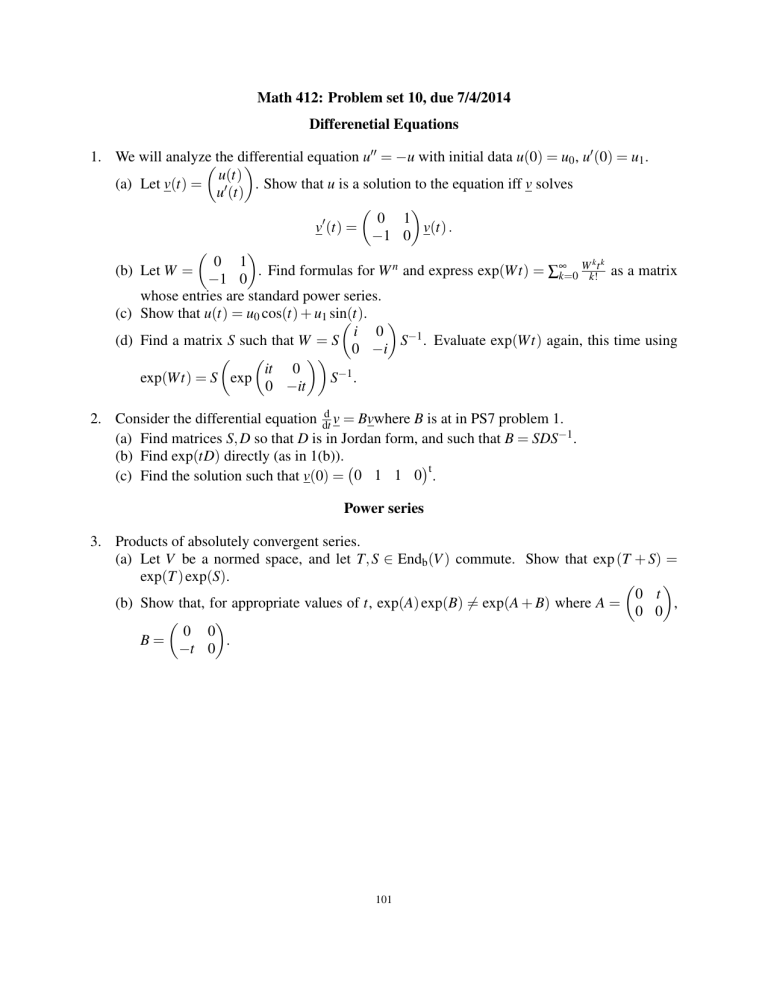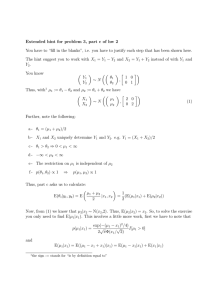Math 412: Problem set 10, due 7/4/2014 Differenetial Equations 1.
advertisement

Math 412: Problem set 10, due 7/4/2014 Differenetial Equations 1. We will analyzethe differential equation u00 = −u with initial data u(0) = u0 , u0 (0) = u1 . u(t) (a) Let v(t) = 0 . Show that u is a solution to the equation iff v solves u (t) 0 1 0 v (t) = v(t) . −1 0 0 1 W kt k . Find formulas for W n and express exp(Wt) = ∑∞ (b) Let W = k=0 k! as a matrix −1 0 whose entries are standard power series. (c) Show that u(t) = u0 cos(t) + u1 sin(t). i 0 (d) Find a matrix S such that W = S S−1 . Evaluate exp(Wt) again, this time using 0 −i it 0 exp(Wt) = S exp S−1 . 0 −it 2. Consider the differential equation dtd v = Bvwhere B is at in PS7 problem 1. (a) Find matrices S, D so that D is in Jordan form, and such that B = SDS−1 . (b) Find exp(tD) directly (as in 1(b)). t (c) Find the solution such that v(0) = 0 1 1 0 . Power series 3. Products of absolutely convergent series. (a) Let V be a normed space, and let T, S ∈ Endb (V ) commute. Show that exp (T + S) = exp(T ) exp(S). 0 t (b) Show that, for appropriate values of t, exp(A) exp(B) 6= exp(A + B) where A = , 0 0 0 0 B= . −t 0 101 Companion matrices 1 1. PRAC Find the Jordan canonical form of 0 0 2 0 1 0 0 0 0 0 1 0 0 . be the companion matrix associated with the polyno. 4. Let C = . 0 0 0 0 0 0 0 0 1 a0 a1 · · · an−2 an−1 k mial p(x) = xn − ∑n−1 k=0 ak x . (a) Show that p(x) is, indeed, the characteristic polynomial of C. – For parts (b),(c) fix a non-zero root λ of p(x). (b) Find (with proof) an eigenvector with eigenvalue λ . (**c) Let g be a polynomial, and let v be the vector with entries vk = λ k g(k) for 0 ≤ k ≤ n − 1. Show that, if the degree of g is small enough (depending on p, λ ), then ((C − λ ) v)k = λ (g(k + 1) − g(k)) λ k and (the hard part) that ((C − λ )v)n−1 = λ (g(n) − g(n − 1)) λ n−1 . (**d) Find the Jordan canonical form of C. Holomorphic calculus m Let f (z) = ∑∞ m=0 am z be a power series with radius of convergence R. For a matrix A define ∞ m f (A) = ∑m=0 am A if the series converges absolutely in some matrix norm. 5. Let D = diag (λ1 , · · · , λn ) be diagonal with ρ(D) < R (that is, |λi | < R for each i). Show that f (D) = diag ( f (λ1 ), · · · , f (λn )). 6. Let A ∈ Mn (C) be a matrix with ρ(A) < R. (a) [review of power series] Choose R0 such that ρ(A) < R0 < R. Show that |am | ≤ C(R0 )−m for some C > 0. (b) Using PS8 problem 3(a) show that f (A) converges absolutely with respect to any matrix norm. (*c) Suppose that A = S (D + N) S−1 where D + N is the Jordan form (D is diagonal, N uppertriangular nilpotent). Show that ! n f (k) (D) k −1 f (A) = S ∑ N S . k! k=0 Hint: D, N commute. RMK1 This gives an alternative proof that f (A) converges absolutely if ρ(A) < R, using the fact that f (k) (D) can be analyzed using single-variable methods. RMK2 Compare your answer with the Taylor expansion f (x + y) = ∑∞ k=0 (d) Apply this formula to find exp(tB) where B is as in problem 2. 102 f (k) (x) k k! y .






